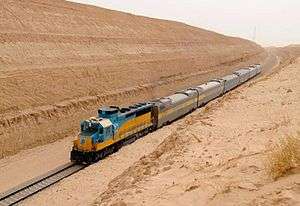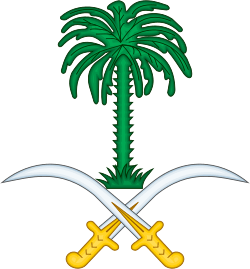Saudi Railways Organization
The Saudi Railways Organization (SRO) (Arabic: المؤسسة العامة للخطوط الحديدية) is one of two state-owned companies that operates Saudi Arabia's rail network. The SRO operates a network of railways with a total length of approximately 1,380 kilometers. The network consists of two main lines. A 449 km passenger line that links Dammam with Riyadh, and a 556 km freight line that connects the King Abdul Aziz Port in Dammam with Riyadh In addition, about 373 km of auxiliary lines branch from SRO's main lines and connect some industrial and agricultural areas, and military sites, with export ports and residential areas.
 Passenger train on the Dammam-Riyadh Line. | |
Native name | المؤسسة العامة للخطوط الحديدية |
|---|---|
| Founded | 13 May 1966 |
| Headquarters | Dammam railway station, , Saudi Arabia |
Area served | Saudi Arabia |
Key people |
|
| Revenue | SAR 535 million[1] (2014) |
| Website | saudirailways.org |
There are plans to extend the network to the Red Sea port of Jeddah and, eventually to the borders of Jordan, Yemen, and perhaps all the way to Egypt.[2]
History
The first railway in modern Saudi Arabia was the Hejaz Railway, from the border of Jordan to Medina. This 1,050 mm (3 ft 5 11⁄32 in) narrow gauge railway opened in 1908, but closed in 1920.
Modern railways were introduced in Saudi Arabia after World War II, to facilitate the transport of goods for the Arabian American Oil Company, or Aramco (now Saudi Aramco), from ports located on the coast of the Persian Gulf to warehouses in Dhahran. Construction began in September 1947, and the first line was inaugurated on 20 October 1951. It was initially run by Aramco, but subsequently transferred to the Ministry of Finance, during which time it was known as the Railway Department. On 13 May 1966, the Saudi government issued a royal decree establishing the Saudi Railways Organization (SRO) to operate the railway system. Several development projects have been completed since then, including an extension of the line to Riyadh, construction of several passenger terminals and the opening of a dry port in Riyadh.[3]
Network

The SRO operates a network of railways with a total length of approximately 1,380 kilometers. Two main lines connect King Abdul Aziz Port in Dammam with Riyadh, while the other connects the city of Dammam with Riyadh. In addition, some auxiliary lines branch from SRO's main lines connect some industrial and agricultural areas and military sites with export ports and residential areas.[4] The network consists of the following lines:
Dammam–Riyadh line
The Dammam–Riyadh line is a 449 kilometer passenger line that connects Dammam with Riyadh, via Al-Ahsa and Abqaiq.
Haramain High Speed Railway
Haramain HSR is a high speed rail line linking Mecca and Medina, and connecting with the rest of the network at Jeddah. This will provide a safe and comfortable means of transport for Hajj pilgrims arriving via Jeddah. Construction works began in 2009, service started in October 2018. 320 km/h electric trains are planned.[5]
Cargo line
The cargo line is a 556 kilometer line that begins at the King Abdul Aziz Port in Dammam and passes through Al-Ahsa, Abqaiq, Al-Kharj, Haradh and Al-Tawdhihiyah, before terminating in Riyadh.
Planning for the line started in 1947 with an agreement between King Ibn Saud and ARAMCO to lay a 547 km (about 340 mi) freight line. Bechtel Construction Company was chosen to build the rail line and a sea port at the eastern end of the rail line at Dammam. Construction of the line began in September 1947. In 1948, veteran American railroad engineer James H. Gildea was hired to oversee the project. The most serious obstacle to building the rail line was the Persian Gulf shallows at Dammam. To allow deep draft vessels to unload, a rail causeway of approximately seven miles was built out into the Persian Gulf with the first five miles a rock causeway and the last couple of miles a section made of a steel trestle. One of the first vessels to unload was a Dutch freighter, in 1950, with a load of rails for construction of the line. The first trains started moving between Dammam and Riyadh in the early 1950s.[6]
Branch lines
Branch lines have a total length of 373 kilometers, and connect some industrial and agricultural production sites, and some military sites, with export ports and some residential areas.
Rolling stock
The SRO's fleet consists of 102 diesel locomotives and 75 passenger cars. These are classified into 12 cars of Al-Rehab class with a capacity of 540 seats, 9 cars of Al-Taleaa class with a capacity of 652 seats, 25 cars of Al-Qafila class with a capacity of 2,012 seats along with 2 special-class cars, 8 diner cars, 12 luggage and power generation cars and 1 car that has been specially fitted as an ambulance car to enhance safety. The company has 2,596 cargo cars of different sizes and types, including 858 cars for double stacking of containers, 948 regular cars for containers, 201 cement transportation cars, 135 grain hauling cars, 47 flatbeds for transporting vehicles and 60 cars for hauling rocks. The capacity of each double stacking cargo car is 80 tons. Regular cars for containers have a capacity of 50 tons. The total capacity of cargo handling by both types of cars in SRO is 48,250 tons.[7]
Spanish manufacturer CAF delivered eight fast diesel locomotives in 2012, with one driving van trailer passenger car and four other passenger cars, with a leading power car unit; plus two spare power cars. They are used on the Dammam–Riyadh Line. During 2013 the travel time is 4:15 but there is a target of 3:00 for the future.
| Class | Image | Top speed | Number | Remarks | Built | |
|---|---|---|---|---|---|---|
| mph | km/h | |||||
| ALCO RS-1 | 6 | Series 1000-1005 Diesel-electric locomotives. Originally Arabian American Oil Company A11x50-A11x51, 1002-1005 | 1947-1951 | |||
| EMD SW1001 | 5 | Series 1022-1026 Order 818000 1/5 Diesel-electric locomotives.[8] | 1981 | |||
| Class 2400 |  |
50 | 80 | 7 | Secondhand Diesel-electric locomotives taken over from NS by Volker Stevin in 1976 for construction works for a seaport in Jubail. Former 2427, 2445, 2485, 2497, 2499, 2519, 2523. Renumbered into 101-107. Sold to Archirodon for rail reconstruction between Damman and Riyadh and renumbered to 276-04 - 276-09. Some scrapped in 1983. Others active until 1994 and stored in Hofuf afterwards.[9] | 1954-56 |
| EMD G18 | 16 | Series 1006-1021 Orders 710971-710975, 713081-713082, 713233-713235, and 748005 1/6 Diesel-electric locomotives. | 1968-1976 | |||
| EMD GP18M | 1 | Series 1200 Order 700178 Diesel-electric locomotives.[8] rated at 1500 horsepower | 1961 | |||
| EMD FP7A | 2 | Series 1500-1501 Order 7019 Diesel-electric locomotives taken over from Arabian American Oil Company (their 1006-1007).[10] | 1953 | |||
| EMD FP9A | 7 | Series 1502-1508 Orders 701553, 701493-701494, 702272-702275 Diesel-electric locomotives | 1956-1959 | |||
| GP38-2 | 1 | Series 2000. Order 712783. Diesel-electric locomotives | 1973 | |||
| GPL38S | 7 | Series 2001-2007. Order 201288865. Diesel-electric locomotives | 2015 | |||
| GT22CW | 3 | Series 2001-2003. Order 748004. Diesel-electric locomotives | 1976 | |||
| SDL38-2 | 6 | Series 2004-2009. Order 778050. Diesel-electric locomotives[11] | 1978 | |||
| SDL38 | 6 | Series 2030-2035. Order 20148061 Diesel-electric locomotives | 2016 | |||
| EMD SDL50 | 31 | Series 3500-3530 Diesel-electric locomotives[12] | 1981-2005 | |||
| EMD SD70ACS | 61 | Series 4000-4060 Diesel-electric locomotives for a mineral railway[13] | 2010-2016 | |||
| GT46ACS | 17 | Series 4300-4316. Orders 20118517 and 20148134. Diesel-electric locomotives | 2013-2015 | |||
| CAF | 112 | 180 | 8 passenger units, 10 power cars (5001-5010) | Passenger trainsets with dedicated power cars. | 2011 | |
| Class 319.2 | 75 | 120 | >4 | Diesel-electric locomotives bought second hand.[14] | ||
Expansion
The SRO has several plans to expand the network as part of the Saudi Railway Master Plan 2010-2040 (SRMP). Some of the projects under the plan are:
- Saudi Landbridge: The Landbridge project is aimed at connecting the Red Sea with the Persian Gulf. It will involve the construction of a 950 km line from Jeddah Islamic Port to Riyadh, and a 115 km line from Dammam to Jubail.[15][16]
- North-South line begin in northwestern Saudi Arabia and passes through Al-Jouf, Hail and Al-Qassim regions before terminating in Riyadh. It also has extensions to Hazm Al-Jalamid to transport phosphate, to Al-Zubayrah to haul bauxite, and to Ras Al-Zour where a major port will be constructed to export transported goods.[17]
- The Gulf Cooperation Council Railway Project is a propose railway network of 2116 km linking all GCC countries. The length of the track inside Saudi Arabia would be 663 km.[18]
- The SRO also has plans to construct three lines in southern Saudi Arabia to improve the region's connectivity with the rest of the country. The lines are the Taif-Khamis Mushayt–Abha line (706 km), the Jeddah-Jizan line (660 km), and the Yanbu–Jeddah line (350 km).[19]
References
- https://www.saudirailways.org/sites/SRO/Pages/en-us/AboutUs/Statistics/Statistics.pdf
- https://web.archive.org/web/20070928205258/http://www.saudirailways.org/english/railway_stations.htm. Archived from the original on September 28, 2007. Retrieved August 1, 2008. Missing or empty
|title=(help) - "SRO".
- "SRO".
- "Al Rajhi wins Makkah - Madinah civils contract". Railway Gazette International. 2009-02-09.
- "American Railroad on the Arabian Desert." Popular Mechanics, April 1952, pp. 107–110.
- "SRO".
- "Saudi Arabia - Saudi Railways Organisation : Prototypes by Country - TT scale trains and models".
- Dierdorp, Sicco & Davy Beumer (2011), D.E.-Locomotieven serie 2200/2300 en 2400/2500. Alkmaar: De Alk
- "Pictures of SRO 1501".
- Ward, compiled by Jeffery S. "EMD 778050; SDL38-2; Saudi Arabia; Gov't Ry 2004-2009".
- "RailPictures.Net Photo: SRO 3527 Saudi Railways Organization EMD SDL50 at Riyadh, Saudi Arabia by Tom Hewitt".
- HaRakevet: Rothschild PhD, Rabbi Walter (2010), New mineral railway Issue 90
- "World rolling stock market May 2014", www.railwaygazette.com, 11 May 2014
- "SRO".
- "Saudi bidding hots up". Railway Gazette International. 2008-03-10.
- "SRO".
- "SRO".
- "SRO".
